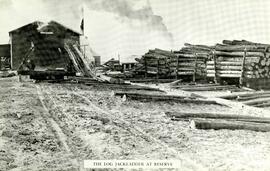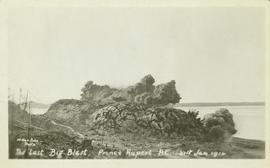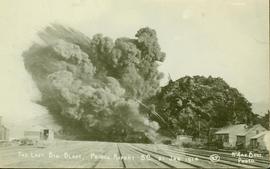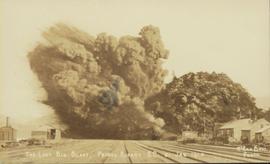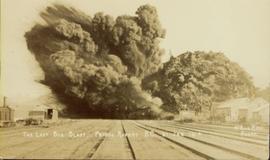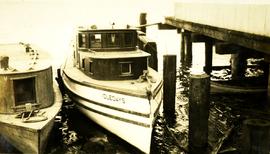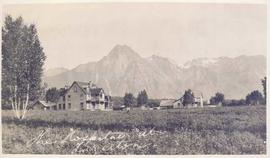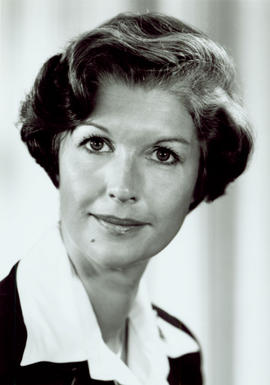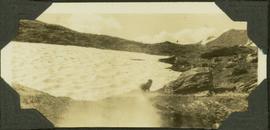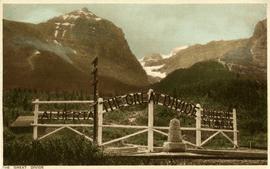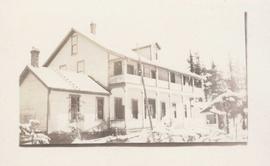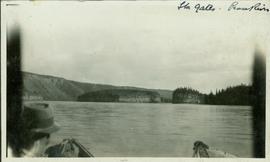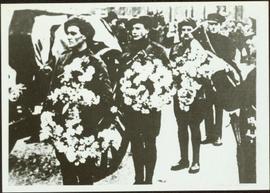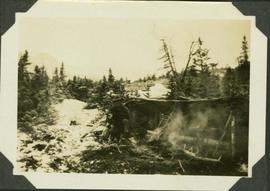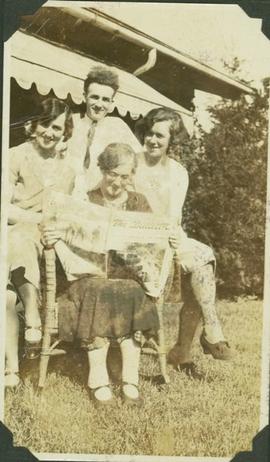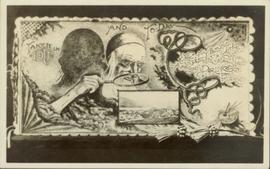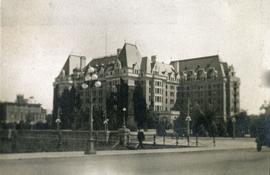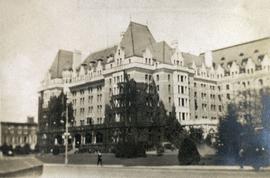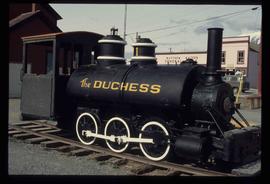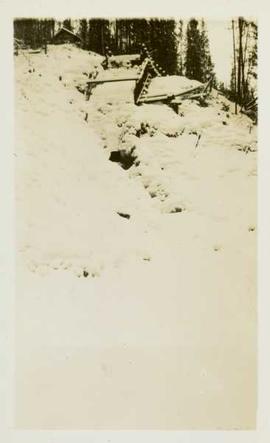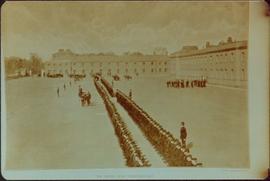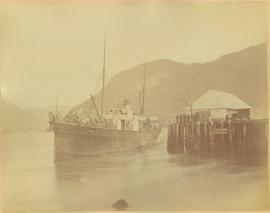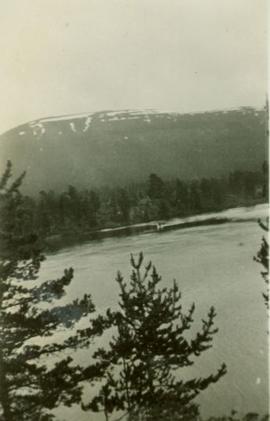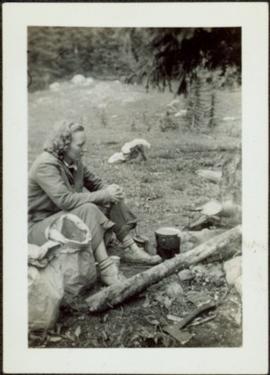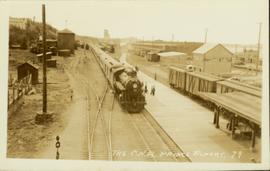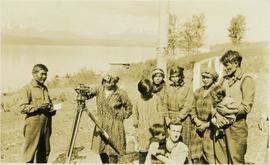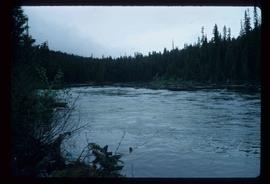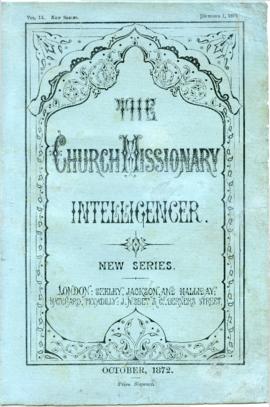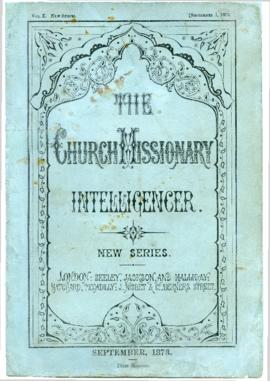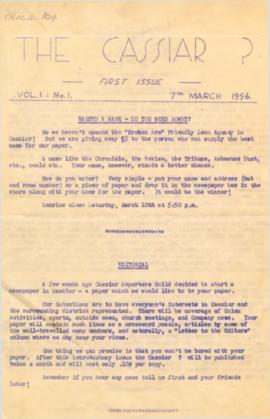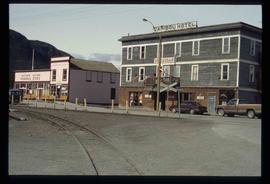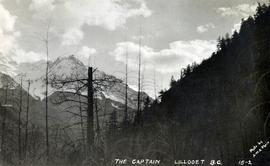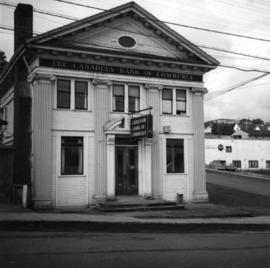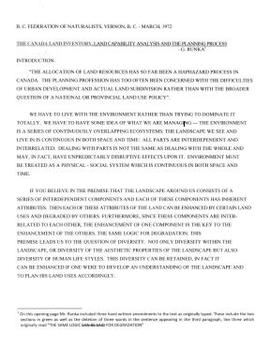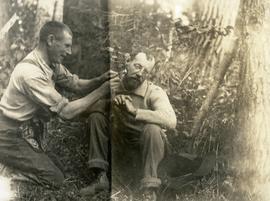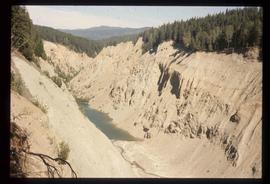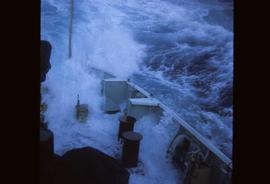The item is a photograph depicting a jack ladder loading logs from the sleighs into the sawmill during the winter. Annotations on the reverse side of the photograph state, "The Pas Lumber Company Ltd. Logs & Sawmill early 1950's Reserve, Saskatchewan."
Image is of an explosion within the railyards of Prince Rupert, BC. Photo is on recto of a blank post card made in Canada.
Image is of an explosion within the railyards of Prince Rupert, BC. Photo is on recto of a blank post card made in Canada.
Photograph of a large explosion next to a huge pile of debris. Buildings are visible on either side and railroad track can be seen in the foreground. Printed annotation on recto reads: "The Last Big Blast, Prince Rupert BC 21 Jan 1914 McRae Bros. Photo"
Photograph of a large explosion next to a huge pile of debris. Buildings are visible on either side and railroad track can be seen in the foreground. Annotation on recto reads: "The Last Big Blast, Prince Rupert BC 21 Jan 1914 McRae Bros. Photo"
This "The Land is Yours" film is a promotional film produced by the British Columbia Department of Agriculture in Kelowna, ca. 1968 or 1969. The film was produced by Gary Runka and hosted by Russ Richardson. Runka and Richardson provide commentary throughout the film. The film was directed by Nobert Hartig.
File consists of a speech given by Gary Runka to the BC Federation of Agriculture in Prince George entitled "The Land Commission and the Role of the B.C.F.A. Advisory Committee".
Commentary on this speech by Barry Smith of the Ministry of Agriculture and Lands:
"GGR uses this speech to particularly emphasize the work of the BCFA Regional Advisory Committees appointed to assist the Commission by providing advice.
Several specific examples are given of where the assistance of the Advisory Committees will be helpful.
GGR briefly outlines the work and challenges of the Commission to date. The speech ends with a list of six "general areas of concern". The list is very perceptive, revealing several of the challenges the Commission was facing at this early stage in the program including:
- Breakdown of viable production units through the sale of existing legal parcels;
- Rangeland tenure and management;
- Integrated use complications;
- Impact of major development proposals within or adjacent to the ALR;
- Small holdings owned by non-rural people in the ALR; and
- Urban re-direction away from the ALR and rural / urban interface conflicts.
The last line of p. 5 is partially hidden and reads: "...more than willing to meet with any of you individually as time permits."
Item is a panoramic photograph of Ingenika Valley.
File consists of a speech given by Gary Runka entitled "The Importance of Agriculture to BC and the Creston Valley" Creston Valley Agricultural Society.
Commentary on this speech by Barry Smith of the Ministry of Agriculture and Lands:
"The speech begins with a number of recent urban newspaper headlines illustrating the level of awareness and the stress on agriculture.
The paper is broken into several major topics:
(I) The Options - in which two perspectives are outlined - one positive that agriculture has social value and is vitally important to the province and second, that agriculture is ultimately doomed.
(II) The Agricultural Land (Water) Base - 11 different land use planning issues are reviewed from an agricultural perspective. It is stressed that agriculture must become a more integrated part of the overall planning process.
(III) The Economic and Social Well Being of the Farming Community. It is noted that there are strong feelings in rural communities that government bureaucrats impose planning and resource management decisions on them rather than plan with or for them. Thus, if agriculture is to thrive it must, once again, become a more integrated part of the overall planning process and the agricultural land base must be assured.
(IV) The Ecological and Economic Sustainability of Agriculture - A key agricultural land conservation measure will be the redirection of regional and local urban growth to available and suitable lands outside the ALR. Provincial and local zoning is seen as a first step framework for managing competition for agricultural land.
Betterment Recapture - this (possibly Henry George inspired) comment reflects the need to recapture a portion of the appreciated value when agricultural land is converted to urban uses as a hedge against speculative forces.
The paper ends by encouraging farm areas like the Creston Valley to take pride in their agricultural community because the opportunity exists for a vibrant, healthy sustainable future."
Photograph depicts a boat named Idledays tied to a pier. Handwritten annotation below the image reads, "Later Algoma".
Photograph depicts numerous buildings with a grassy field in the foreground and a mountain range in the background. Annotation on recto of photograph states: "The Hospital at Hazelton"
This fonds illustrates the Honourable Iona Campagnolo’s careers as a broadcaster, a theatre producer, community leader, a politician, a feminist, a social activist, a speaker, a lecturer, a Chancellor, an advocate, a consultant and Lieutenant Governor of British Columbia. Types of records reflective of her various careers include: speeches, correspondence, itineraries, contracts, draft manuscripts, newspaper clippings, background material, photographs and ephemera. The Honourable Iona Campagnolo fonds has been divided into the following thirteen series:
1) Photographs
2) Theatre & Community Development
3) Political Career
4) Non-political Activities
5) McMaster International Health Centre
6) Women in Power Project
7) University of Northern British Columbia
8) Fraser Basin Council
9) Miscellaneous – First Nations Material
10) National Speakers Bureau
11) Lieutenant Governor of British Columbia
12) Honours & Awards
13) Political Papers
Caption: Our small friends: the ground-hog, whistler, marmot. Sentinel of the glen.
Postcard depicts the Canadian Pacific Railway line where the Great Divide between BC and Alberta.
Photograph depicts a snow covered building. Annotation on verso of photograph states: "The good old winter time at the Hospital aR"
Photograph depicts three uniformed men, holding memorial wreaths lined up beside a casket on a wagon. Handwritten annotation on verso of photo reads: “The funeral of British Agents shot on Bloody Sunday. Auxiliaries and R.I.C. form Guard of Honour.”
Item is a photograph of a survey crewman kneeling outside his tent after the first snowfall.
Item is a photograph of two young women and one elderly woman and one young man posing for am informal photograph in a garden. The elderly woman is seated and is reading "The Bulletin" newspaper.
Photograph of an illustration of an elderly man peering over a photograph of Prince Rupert, BC with a magnifying glass. Beaded leather tassels are affixed to the edges of the illustration. Printed annotation on recto reads: "Taken in 1911. And Today The Eyes of the World are on Prince Rupert. Craig N of Prince Rupert."
Photograph depicts the Empress Hotel in Victoria, BC.
Photograph depicts the Empress Hotel in Victoria, BC.
The BC Ministry of Forest's EP 1148 Long-term Soil Productivity (LTSP) study addresses two key factors— soil porosity and site organic matter—that potentially limit tree growth and site productivity in the timber-harvesting land base and that can be affected by forestry operations.
This establishment report for EP 1148, "The effects of soil compaction and organic matter retention on long-term soil productivity in British Columbia (Experimental Project 1148)", is accompanied by a floppy disk containing 12 data sets (see 2023.2.2.11.2).
Item is a photocopied version of Percy Barr's "The Effect of Soil Moisture on the Establishment of Spruce Reproduction in British Columbia" from the Yale University School of Forestry Bulletin No. 26.
Item is an original issue of British Columbia Forest Service Research Notes on "The Durability of Scarified Seedbeds for Spruce Regeneration" by Arlidge.
Image depicts the Duchess engine, which was built in 1878 and taken out of service in 1919. It was part of a matched set with the Duke and is now a tourist attraction in Carcross, Y.T.
Photograph depicts a hillside and mining equipment covered in heavy snow.
Photograph depicts an overview of a large formation of Royal Irish Constabulary constables lined up for inspection by the Director General in the courtyard of Garda Headquarters, "The Depot," located in Phoenix Park, Dublin, Ireland. Typed annotation on recto of photograph states: "The Royal Irish Constabulary"
Item is a photocopied version of G.H. Barnes' "The Development of Unevenaged Stands of Engelmann Spruce, and Probable Development of Residual Stands after Logging" reprinted from The Forestry Chronicle, 1937, Vol. 13, No. 3.
Group of men stand on pier by warehouse, looking out at the boat. Treed mountains visible in background.
Handwritten photo caption beside image reads: "Danube".
Item is a landscape photograph of Tatlatui Lake, mountains and trees.
Item is a photograph of Gladys Williston sitting at a campfire during her and Mr. Williston’s Hope to Princeton trek in the summer of 1939.
Slightly elevated front-facing photograph of a steam engine and cargo coming into a station in Prince Rupert, BC. Coal and lumber yards are visible in the background. Annotation on recto reads: "The C.N.R. Prince Rupert. 79."
Item is a group photograph of First Nations men, women and children standing around surveying equipment situated next to Takla Lake. One non-native (Mackenzie?) is kneeling in the foreground with a young child in his arms.
Image depicts a section of Isaac Lake which is apparently known as the "chute."
A monthly journal published by the Church Missionary Society (CMS) featuring the work of CMS missionaries around the world. Note: pages 315-320 are missing.
A monthly journal published by the Church Missionary Society (CMS) featuring the work of CMS missionaries around the world.
On March 7, 1956 the Cassiar Reporters Guild published one issue of an untitled newspaper simply titled "The Cassiar '?'" (vol.1, no.1) along with a "name that newspaper" contest call out to the local community. It is believed that no other issue of this first volume was published until December 7, 1957 when The Asbestos Sheet (vol.2, no.1) was published. The Asbestos Sheet, was generally published twice a month and ran from December 1957 to September 1976; after which time both its name and its format changed: the 8-1/2 x 10" news bulletin changing to an 11 x 17" newspaper; and The Asbestos Sheet becoming the Cassiar Courier. The Courier was published monthly from fall 1976 until February 1991 when it stopped circulation shortly before the closure of both the mine and the company town.
Image depicts the Caribou Hotel and the Matthew Watson General Store in Carcross, Y.T.
Photograph depicts a view of "The Captain" mountain near Lillooet, BC.
Photograph depicts the Canadian Bank of Commerce in Ladysmith, B.C. on Vancouver Island. Building is estimated to be built between 1901-1905.
File consists of a speech given by Gary Runka to the Kelowna Chamber of Commerce Environment Committee entitled "The Canada Land Inventory, Land Capability Analysis and the Chamber of Commerce".
Commentary on this speech by Barry Smith of the Ministry of Agriculture and Lands:
"GGR makes the point in opening that the Chamber of Commerce may not be a group the public normally associates with concern for the environment but he feels it is time to correct this fallacy.
This speech is of value, if for nothing else, for the outline provided of the origin of the Canada Land Inventory (page 2).
Interestingly in the light of a future Land Commission publication, GGR uses the phrase "...with proper inventory information perhaps we would have left some of our options open". The 15 page B.C. Land Commission booklet published in March 1975 [was titled 'The B.C. Land Commission: Keeping the Options Open']."
File consists of a speech given by Gary Runka to the BC Federation of Naturalists in Vernon entitled "The Canada Land Inventory, Land Capability Analysis and the Planning Process".
Commentary on this speech by Barry Smith of the Ministry of Agriculture and Lands:
"This speech largely avoids technical detail and an outlining of the mechanics of land capability analysis but does provide several practical examples that allow for a better understanding of the application of the analytical work.
The summary on page 11 is particularly important (in part):
"Planning must anticipate desirable land use patterns, not merely react to the pressure of short run expedients. Above all else let's not forget that land use planning should be people-oriented as well as resources-oriented. Hopefully, facts rather than short term
economics, politics, or emotions will play an increasing role in decision-making."
The speech was accompanied by slides.
(Note: Via a handwritten amendment the title was changed from "Land Capability Analysis and the Planning Process" to 'The Canada Land Inventory, Land Capability Analysis and the Planning Process"
Photograph depicts one man kneeling the other sitting on the forest floor. The first man is giving the second man a shave.
Image depicts the Bullion Pit in Likely, B.C. It is a man-made canyon from the days of the gold-rush, formed by the use of hydraulic monitors. The gold-mine operated from 1892 to 1942.
File consists of a speech given by Gary Runka entitled "The British Columbia Experience" for the Planning for Rural Growth event in Whatcom County, Bellingham, Washington.
Commentary on this speech by Barry Smith of the Ministry of Agriculture and Lands:
"This is an important overview document of the farmland preservation program, summarizing the situation after about 6 years since the program's introduction.
There are several interesting points made in the paper - which was given to a non-BC / Canadian audience. A sample of these points included:
- The ALR is based on ecological characteristics of the land and this was very important to the ALR's
success; - The ALR is a long term zone;
- The legislation is not enough - the ALR will not be secure until agriculture and the farming community become an integral part of planning at every level;
- The Langley Properties and work of the Property Management Branch which re-surveying the properties into viable commercial farm units;
- Conflicting priorities of provincial agencies create difficulties;
GGR observes that the Commission has the opportunity "... to have provincial input into planning for agriculture." This is an action, that in due course, the Commission would play a leadership role."
Map depicts location of treasure hidden between Clearwater and Clemina, BC.
File consists of a speech given by Gary Runka entitled "B.C. Agricultural Land Preservation Program". This speech was originally given on March 23, 1977 at the Sol Conservation Society of America National Symposium. Includes a version of the speech turned into a paper submitted for publication as "British Columbia's Agricultural Land Preservation Program" in the Assessors Journal. The speech and paper is accompanied by:
- supplementary transparencies for presentation
- Resume for G. Gary Runka
- Canada Land Inventory Ratings
- Summary of Applications Processed under the Land Commission Act
- Areas Included and Excluded from the ALR by Year
- Flow Chart for Applications under the Agricultural Land Commission Act
Commentary on this speech by Barry Smith of the Ministry of Agriculture and Lands:
"This speech was given on March 23, 1977 and represents a major paper given to an international audience.
GGR provides a contextual overview of B.C. and breaks his speech into an overview of the legislation, how the ALR was established and the administration of the Reserve.
The speech, in part, draws upon themes in other speeches but this paper tends to pull all these subjects together in this single presentation.
GGR notes that up to this point 80% of the exclusion applications are from non-farmers and it is estimated that the program has saved 40,000 acres (16,187 ha.) of farmland from being converted to irreversible uses.
GGR outlines several key principles to having a successful program to preserve agricultural land including:
- Regulations must be based on solid technical data people can understand;
- Any control mechanism needs to be basically apolitical;
- Must include shared decision-making - local governments and the public were involved in creating the ALR plans and local governments continue to provide comments and recommendations on applications; and
- Ensure opportunity for integration and communication with the Ministry of Agriculture and other provincial government agencies and Advisory Committees of the B.C. Federation of Agriculture.
This speech was published as part of the symposium proceedings: "Land Use, Tough Choices in Today's World: The Proceedings of a
National Symposium, March 21-24,1977, in Omaha, Nebraska" by the Soil Conservation Society of America."
